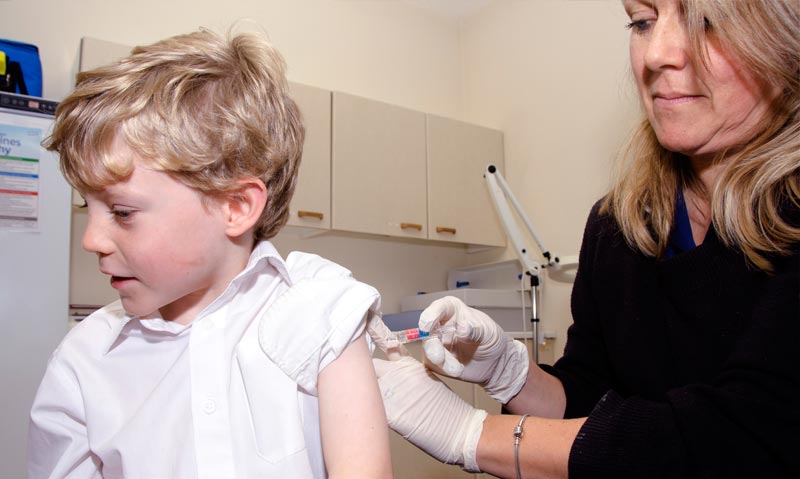ACTIVE monitoring of the safety and effectiveness of influenza vaccine should become a routine, funded component of Australia’s influenza vaccine program, says an Australian expert in infectious disease epidemiology.
Writing in the MJA, Professor Heath Kelly, head of the epidemiology unit of the Victorian Infectious Diseases Reference Laboratory, said the experience of 2010, when there was a spike in fever and febrile convulsions in young children who had been given bioCSL’s Fluvax and Fluvax Junior, suggested that assuming past safety predicted present safety might not be valid. (1)
“In the light of unexpected safety signals and sometimes low estimates of effectiveness, annual monitoring of the safety and effectiveness of influenza vaccines now seems like good public policy”, he wrote.
Professor Kelly’s editorial accompanied an MJA study that found the 2013 influenza vaccines were safe and well tolerated in children aged from 6 months to under 10 years. (2)
The federal government-funded active prospective surveillance study monitored the post-immunisation experience of 893 children vaccinated at six Australian paediatric hospital clinics between March and July 2013, via phone interviews with parents and carers 3‒5 days after immunisation.
A Department of Health spokesperson said the department supported several enhanced surveillance activities to monitor adverse events following immunisation (AEFI), including the 2014 AusVaxSafety Project for influenza vaccination in children aged under 5 years. (3)
“A decision on the continuation of enhanced AEFI surveillance for influenza vaccine will be considered by the department during its planning for the 2015 seasonal influenza vaccination program funded under the National Immunisation Program”, the spokesperson told MJA InSight.
A range of activities were used to monitor vaccine safety, including routine passive surveillance of adverse events reported to the Therapeutic Good Administration, the spokesperson said.
Professor Robert Booy, head of the clinical research team at the National Centre for Immunisation Research and Surveillance, said improved safety and effectiveness surveillance of vaccines was necessary, but there were many challenges beyond data collection.
“Deciding what to do with the data is harder than collecting the data”, he told MJA InSight.
Professor Booy said while the low 6% fever rate shown in the MJA study was reassuring, he questioned whether fever was the perfect correlate for vaccine safety.
He said it was possible that a vaccine associated with a higher fever rate could still be safe and effective.
“It points to the difficulty of doing this research. If you use fever as a correlate, you may then not make the right decision about a vaccine that’s very effective because it may cause fever but not febrile convulsions”, he said. “To know whether [a vaccine] causes febrile convulsions requires thousands of children to be studied, which is not really feasible in the current circumstances.”
Professor Booy also noted that the MJA study provided useful data on only one of the three vaccines studied with about 74% of the children receiving Vaxigrip/Vaxigrip Junior, but only 12.5% and 10.4% receiving Fluarix and Influvax/Influvax Junior, respectively.
The MJA study authors described the requirement for nurses to phone parents to solicit information about vaccine reactions as time consuming and pointed to programs using mobile phone text messaging and web-based technology as possible alternatives.
Public health physician Dr Craig Dalton told MJA InSight monitoring vaccine safety was an important public health investment. Dr Dalton piloted Vaxtracker, an active online surveillance program for adverse events following inactivated influenza vaccine in children, which provides data for the AusVaxSafety Project. (4)
He said the Vaxtracker program was modelled on the successful FluTracking.net program. (5)
“All medical interventions, and especially public health interventions, are built on a foundation of trust. And we have seen the impact on vaccination coverage when that trust gets assaulted, such as the false claims of a link between autism and childhood vaccinations”, Dr Dalton said.
“Monitoring vaccination safety and showing that public health agencies value the importance of safety monitoring is a really important investment.”
WA GP Dr Alan Leeb developed an automated SMS-based system for monitoring adverse events after immunisation following the 2010 spike in vaccine reactions. (6)
The system is now used in nine general practices and will soon be used by the Perth Central Immunisation Clinics. There was also national interest in the program, which has a more than 80% response rate.
“Depending on the state, 60%‒70% of all vaccines are delivered in general practice”, Dr Leeb told MJA InSight.
“General practice has a duty of care to monitor the safety of vaccines and in turn provide information to health authorities and more importantly to our patients.”
1. MJA 2014; 201: 560-561
2. MJA 2014; 201: 596-600
3. NCIRS: Surviellance AusVax Safety
4. NCIRS: Vaxtracker Project
5. FluTracking.net
6. MJA 2014; 200: 416-418
(Photo: Dr P. Marazzi / Science Photo Library)

 more_vert
more_vert